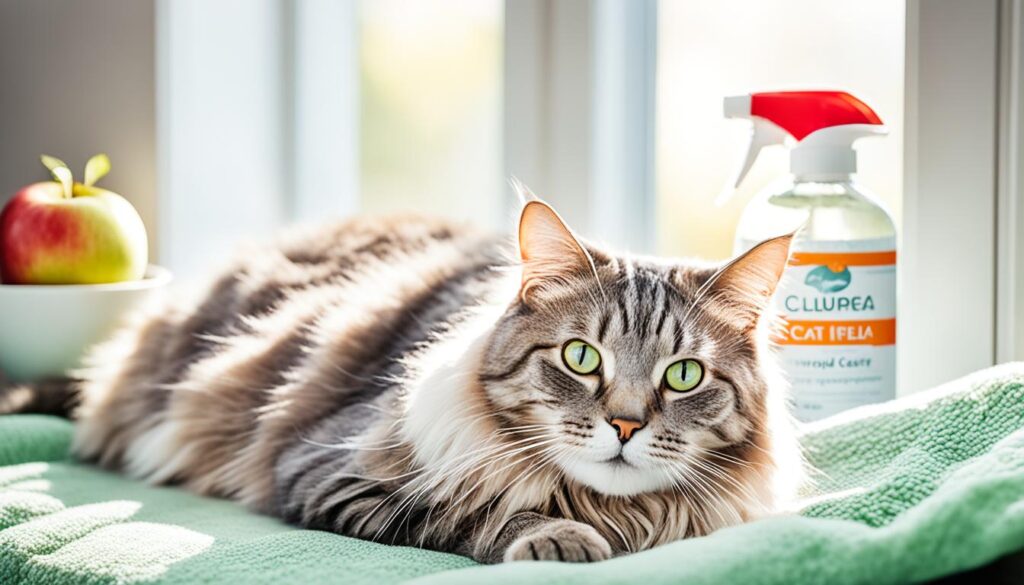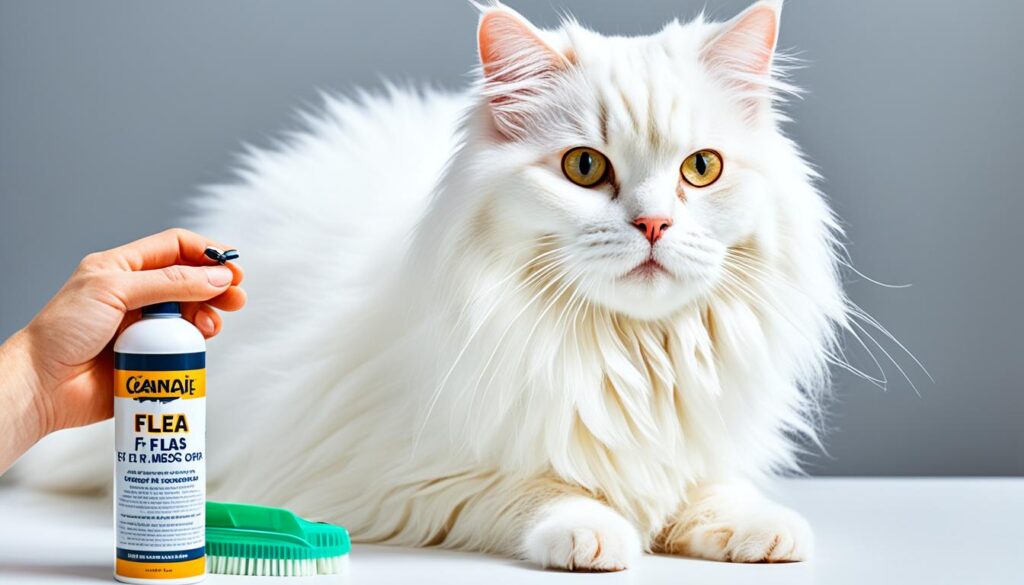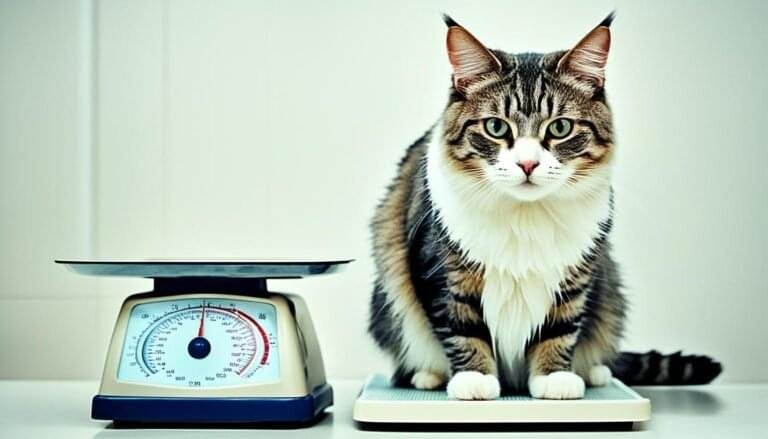Did you know that even though your cat never sets a paw outside, they can still fall victim to flea infestations? It’s a surprising fact, but it’s true. Fleas are tiny but powerful insects that can find their way into your home and onto your indoor cat, causing discomfort and potential health risks. Understanding how indoor cats get fleas is essential in preventing and treating these pesky parasites.
Indoor cats can be exposed to fleas through various sources. They can hitch a ride on other pets, such as dogs, or even on humans, who unknowingly bring fleas into the home on their clothing or shoes. Fleas can also enter your home through visits from other pets, wildlife, or even rodents. It’s important to take preventive measures to protect your indoor cat from flea infestations and ensure their well-being.
Key Takeaways:
- Indoor cats can get fleas despite being kept indoors.
- Fleas can hitch a ride on other pets, humans, and even rodents.
- Preventive measures are crucial in protecting indoor cats from flea infestations.
- Regular flea prevention and treatment are essential for the well-being of indoor cats.
- Understanding the life cycle of fleas is important in preventing and treating infestations.
The Most Common Way for Fleas to Enter Your Home
The most common way for fleas to enter your home and infest indoor cats is through other pets, especially dogs. Even if a dog is on flea preventives, there may still be live fleas present, which can easily transfer onto cats. It’s important to ensure all pets in the home are on year-round flea prevention to reduce the risk of flea infestations in indoor cats.
The Importance of Flea Preventives
Flea preventives are medications that can be administered to pets to kill and prevent fleas. They come in different forms, such as spot-on treatments, oral medications, and collars. These preventives contain active ingredients that target fleas, preventing them from reproducing and infesting your pets.
Using flea preventives is crucial in protecting your pets, especially indoor cats, from flea infestations. Even if your cat rarely goes outside, fleas can still find their way into your home through other pets, as mentioned earlier.
By consistently providing flea preventives to all pets in your home, you create a barrier that kills fleas and prevents them from breeding, effectively stopping the flea life cycle and keeping your indoor cat safe.
Choosing the Right Flea Preventive
When selecting a flea preventive for your pets, it’s important to consult with a veterinarian to determine the best option based on their specific needs. Factors such as the pet’s age, weight, health condition, and the presence of other parasites should be considered.
Veterinarian-approved flea preventives are typically more effective and safer than over-the-counter products. These prescription medications have undergone extensive testing to ensure their efficacy and safety for use in pets.
Flea Preventive Comparison Table
| Preventive | Administration | Duration of Protection | Mode of Action | Additional Benefits |
|---|---|---|---|---|
| Topical Spot-on Treatments | Applied to the skin, usually between the shoulder blades | 30 days | Kills adult fleas, disrupts flea life cycle | May also provide protection against ticks and other parasites |
| Oral Medications | Taken orally, usually in the form of a chewable tablet | 30 days | Kills adult fleas, disrupts flea life cycle | May also provide protection against ticks and other parasites |
| Flea Collars | Worn around the neck | Varies (some offer up to 8 months of protection) | Releases active ingredients that kill and repel fleas | Continuous protection without the need for monthly application |
It’s important to follow the instructions provided by the manufacturer and your veterinarian when administering flea preventives to ensure their maximum effectiveness and safety.
Remember, preventing flea infestations in your indoor cat is much easier and less stressful than treating an existing infestation. By prioritizing flea prevention and using veterinarian-approved products, you can keep your furry friend free from the discomfort and health risks associated with fleas.
Fleas Can Hitch a Ride on Humans
Did you know that fleas can easily hitch a ride on humans and their clothing or shoes, making their way into your home? While it may sound surprising, fleas have the ability to cling onto humans and use them as transportation to find a new host. This means that even if you don’t have any pets, you can still unwittingly bring fleas into your home.
To prevent the spread of fleas, it’s important to take certain precautions. After having house guests or visiting places where fleas may be present, such as parks or outdoor areas, make sure to thoroughly clean up. This includes vacuuming floors and upholstery, washing bedding in hot water, and cleaning any potentially infested areas. By doing so, you can minimize the chances of fleas entering your living space and infesting your indoor cat.
If you suspect that your indoor cat has been exposed to fleas, it’s crucial to check for flea dirt. Flea dirt is the feces of fleas and appears as small, dark specks on your cat’s fur and skin. To determine whether it is flea dirt, take a damp white tissue or cotton ball and rub it along your cat’s fur. If the specks turn reddish-brown, it is a sign of flea infestation.
Please note: Fleas can also transmit diseases to humans, such as Murine Typhus and Cat Scratch Disease. It is essential to take necessary precautions to protect yourself and your family from flea bites and potential health risks.
Rodents as Carriers of Fleas
Rodents, such as mice or rats, can unintentionally bring fleas into your home. These tiny parasites attach themselves to rodents and use them as hosts for survival and reproduction. Unfortunately, if your house has a rodent problem, it increases the likelihood of fleas being brought indoors, which can then infest your indoor cats.
To prevent rodent infestations and reduce the risk of fleas in your home, it’s essential to take proactive measures:
- Keep Floors and Countertops Clean: Regularly sweep and mop your floors and wipe down countertops to eliminate any food debris and crumbs that may attract rodents.
- Seal Off Entry Points: Rodents can find their way into your home through small cracks and openings. Seal off potential entry points, such as gaps in windows, doors, foundations, and vents, to prevent their entry.
By maintaining a clean living environment and blocking off access for rodents, you can effectively minimize the chances of fleas entering your home and infesting your beloved indoor cats.
Tips for Preventing Rodent Infestations
| Preventive Measures | Description |
|---|---|
| Food Storage | Keep all food, including pet food, in tightly sealed containers to remove potential food sources for rodents. |
| Trash Management | Dispose of household trash regularly in bins with secure lids to avoid attracting rodents. |
| Exterior Maintenance | Trim bushes and trees near your home to eliminate hiding spots for rodents. Maintain a clear area around your property. |
| Professional Assistance | If you have a persistent rodent problem, consider seeking the help of a professional pest control service. |
By implementing these preventive measures, you can protect your indoor cats from the potential harm caused by fleas brought in by rodents. Maintaining a clean and rodent-free environment is crucial in ensuring the health and well-being of your feline companions.
Other Places Cats Visit Can Expose Them to Fleas
Cats are curious animals that love to explore their surroundings. Unfortunately, these adventures can sometimes lead them to places where fleas may be lurking. Places such as catteries, shelters, vet offices, groomers, and boarding facilities can be hotspots for fleas.
To protect your cat from flea infestations, it’s crucial to ensure they are on veterinarian-approved flea prevention year-round. By taking proactive measures, you can significantly reduce the risk of your cat picking up fleas from these places they visit.
When it comes to preventing fleas in cats, discussing with your veterinarian is key. They can recommend the best flea prevention options based on your cat’s specific needs and medical history. Veterinarian-approved flea preventives are typically available in various forms, such as topical treatments or oral medications.
Remember, prevention is always better than dealing with a full-blown flea infestation. So, make sure to prioritize year-round flea prevention for your cat, especially if they frequently visit places where fleas may be present.
Take a look at the following table for a summary of the common places where cats can be exposed to fleas:
| Common Places Where Cats Can Be Exposed to Fleas |
|---|
| Catteries |
| Shelters |
| Vet offices |
| Groomers |
| Boarding facilities |
By diligently implementing veterinarian-recommended flea prevention measures, you can ensure that your cat stays safe and free from the annoyance and potential health risks associated with fleas. Stay ahead of the game and keep those pesky fleas at bay!
Fleas in New Homes
Moving into a new home can be an exciting time, but it can also expose indoor cats to the risk of fleas. Carpets and central heating systems provide ideal conditions for flea development, making it important to take preventive measures to protect your furry friend.
When moving into a new home, it’s essential to have professional cleaning services thoroughly treat the entire home, including carpets, upholstery, and any other areas where fleas may hide. Cleaning removes any existing flea eggs, larvae, or pupae that may be present, reducing the risk of a flea infestation.
Note: Insert relevant information about professional cleaning services here.
If the previous homeowner had pets, it’s crucial to consider using a flea preventive product, such as a home fogger, before moving in. This extra step can further minimize the chances of fleas becoming a problem for your indoor cat.
Note: Insert a relevant and visually appealing image related to new homes and flea prevention here.
Additionally, implementing flea prevention strategies on an ongoing basis is key to keeping your indoor cat protected. Regularly vacuuming carpets and discarding the vacuum bag or emptying the canister immediately afterward can help remove any fleas or flea dirt that may be present.
Note: Insert relevant information about effective vacuuming techniques and frequency here.
Remember, be proactive when it comes to flea prevention in new homes. By taking these preventive measures, you can create a safe and comfortable environment for your indoor cat, free from the nuisance and health risks associated with fleas.
| Flea Prevention Tips for New Homes |
|---|
| Have professional cleaning services treat the entire home, including carpets and upholstery. |
| Consider using a flea preventive, such as a home fogger, before moving in if the previous homeowner had pets. |
| Regularly vacuum carpets and dispose of the vacuum bag or empty the canister promptly. |
| Consult with a veterinarian for additional flea prevention advice tailored to your indoor cat’s needs. |
Prevention of Fleas and Ticks for Indoor Cats

The best defense against indoor cats getting fleas is to provide them with regular flea prevention. Veterinarian-approved flea preventives are available and should be given to all pets in the home on a regular basis. These preventives require a prescription and should be administered according to the instructions provided by the veterinarian. Fleas can cause discomfort and pose health risks to both cats and humans, so prevention is essential.
There are several effective options for flea prevention for indoor cats. One of the most common methods is the use of topical spot-on treatments. These treatments are typically applied to the back of the cat’s neck and provide long-lasting protection against fleas and ticks. Some spot-on treatments also offer protection against other pests, such as mosquitoes and lice.
Another popular option for flea prevention is oral medication. These medications are given to the cat orally and work by circulating in the bloodstream and killing fleas when they bite. Oral flea preventives are convenient and highly effective, providing continuous protection for the cat.
In addition to topical and oral preventives, there are also flea collars available for indoor cats. These collars release a small amount of pesticide that kills and repels fleas and ticks. Flea collars are an easy-to-use option and provide long-lasting protection against infestations.
Comparative Table: Flea Prevention Methods for Indoor Cats
| Flea Prevention Method | Administration | Duration of Protection | Effectiveness Against Fleas | Effectiveness Against Ticks |
|---|---|---|---|---|
| Topical spot-on treatments | Applied to the back of the cat’s neck | 1 month | Highly effective | Varies depending on the product |
| Oral medication | Given orally to the cat | 1-3 months | Highly effective | Varies depending on the product |
| Flea collars | Worn around the cat’s neck | Up to 8 months | Effective | Effective |
It’s important to consult with a veterinarian to determine the most suitable flea prevention method for your indoor cat. The choice may depend on factors such as the cat’s age, weight, and overall health, as well as your lifestyle and preferences. Remember to always follow the veterinarian’s instructions when administering flea preventives to ensure the safety and effectiveness of the product.
By implementing a comprehensive flea prevention program, you can protect your indoor cat from the discomfort and health risks associated with fleas and ticks. Regular preventive treatments, along with proper hygiene practices and regular veterinary check-ups, will help keep your cat flea-free and healthy.
The Life Cycle of Fleas
Understanding the life cycle of fleas is crucial when it comes to preventing and treating flea infestations in your home. Fleas go through four distinct stages: eggs, larvae, pupae, and adults. Let’s take a closer look at each stage:
Eggs
Female fleas lay eggs on a host, typically an animal such as a cat or dog. These eggs are small, oval-shaped, and barely visible to the naked eye. A single female flea can lay hundreds of eggs during her lifetime. The eggs are not sticky and tend to fall off the host, dispersing into the environment, such as your home. They can be found in your pet’s bedding, carpet, or furniture.
Larvae
Once the eggs hatch, they give rise to flea larvae. The larvae are small, white, legless creatures that are about 3-5mm long. They are not able to jump like adult fleas and tend to avoid light by hiding in dark, humid areas like carpet fibers, upholstery, or cracks in flooring. Flea larvae feed on organic matter like flea dirt (the feces of adult fleas), dead skin cells, and other debris.
Pupae
Flea larvae then transform into pupae, a cocoon-like stage where they undergo further development. Pupae are protected within silken cocoons, which can act as a barrier against environmental conditions and insecticides. Pupae can remain dormant for several weeks or months, waiting for the right conditions to emerge as adults. Factors like temperature, humidity, vibrations, and the presence of a nearby host can influence their emergence.
Adults
Adult fleas will emerge from their cocoons once they sense the presence of a host nearby. They are small, reddish-brown insects with flattened bodies that allow them to move easily through an animal’s fur. Adult fleas rely on blood meals from their hosts, and they can bite and feed within seconds of landing on a cat or dog. Female fleas are capable of laying eggs within 48 hours after their first blood meal, perpetuating the flea life cycle.
Effective flea prevention and treatment strategies should target all stages of the flea life cycle. By interrupting flea reproduction and eliminating fleas at different life stages, you can successfully control and eliminate flea infestations in your home.
| Stage | Description | Location |
|---|---|---|
| Eggs | Small, oval-shaped eggs laid by female fleas | In the pet’s environment, such as bedding or carpet |
| Larvae | Legless, white larvae that feed on organic matter | In dark, humid areas like carpet fibers or upholstery |
| Pupae | Transforming larvae enclosed in silken cocoons | Dormant in the environment, waiting to emerge |
| Adults | Mature fleas capable of reproducing and feeding on hosts | On the host, such as cats or dogs |
Treating Flea Infestations in Indoor Cats

If an indoor cat becomes infested with fleas, it’s crucial to take immediate action to eliminate the parasites and alleviate your cat’s discomfort. There are several effective treatment options available to combat flea infestations in indoor cats:
Flea Shampoo for Cats
One option is to use a flea shampoo specifically formulated for cats. This shampoo contains ingredients that target and kill fleas on contact, providing quick relief for your cat. When using flea shampoo, it’s important to follow the instructions carefully and thoroughly rinse your cat to remove any shampoo residue.
Spot-on Flea Treatments
Another effective treatment option is spot-on flea treatments. These treatments are applied topically to your cat’s skin, usually between the shoulder blades. Spot-on treatments contain insecticides that kill fleas and prevent reinfestation for several weeks. It’s essential to use spot-on treatments that are specifically formulated for cats, as products designed for dogs can be toxic to cats.
Vacuuming for Fleas
Vacuuming your home regularly is an important part of flea control. By vacuuming carpets, rugs, upholstery, and other surfaces, you can remove adult fleas, larvae, and eggs from the environment. Remember to focus on areas where your cat spends most of their time. After vacuuming, be sure to dispose of the vacuum bag or empty the canister to prevent fleas from reinfesting your home.
In addition to these treatment options, it’s essential to practice good hygiene and cleanliness in your home to support flea eradication:
- Wash your cat’s bedding, blankets, and other fabric items in hot water to kill any fleas or eggs that may be present.
- Clean and vacuum areas where your cat rests or plays, such as furniture, scratching posts, and window sills.
- Consider using a flea comb to remove adult fleas and flea dirt from your cat’s fur.
- Consult with a veterinarian for guidance on the best treatment plan for your cat’s specific needs and the severity of the infestation.
- In severe cases, professional extermination may be necessary to eliminate fleas from your home completely.
Remember, treating flea infestations in indoor cats requires a comprehensive approach that addresses both your cat’s coat and the home environment. By combining appropriate treatment options and diligent cleaning practices, you can effectively eliminate fleas and ensure the well-being of your indoor cat.
Holistic and Non-Insecticide Options for Flea Prevention
As a cat owner, you may be interested in exploring non-insecticide options for flea prevention in indoor cats. While veterinarian-approved flea preventives are the most reliable and effective method, there are holistic approaches that can complement your overall flea prevention strategy.
Frequent Flea Combing
One non-insecticide option for flea prevention is frequent flea combing. This involves using a fine-toothed flea comb to carefully comb through your cat’s fur, checking for fleas, their eggs, and larvae. Flea combing not only helps in the early detection of fleas but also physically removes them from your cat’s coat.
When combing your cat, start from the head and work your way down to the tail, paying close attention to areas like the base of the tail, behind the ears, and under the chin. Have a bowl of soapy water nearby to quickly drown any live fleas you find during the combing process.
Regular Vacuuming to Disrupt the Flea Life Cycle
Another natural flea prevention method is regular vacuuming. Fleas and their eggs can hide in carpets, rugs, upholstery, and other areas of your home. By vacuuming these areas frequently, you can disrupt the flea life cycle by removing the eggs and larvae, reducing the chances of an infestation.
When vacuuming, pay special attention to areas where your cat spends a lot of time, such as their favorite lounging spots. Make sure to empty the vacuum bag or canister immediately after each use to prevent any fleas from re-infesting your home.
While non-insecticide options like flea combing and regular vacuuming can be beneficial in preventing fleas in indoor cats, it’s important to note that they may not be as reliable as veterinarian-approved flea preventives. Flea preventives prescribed by your veterinarian are specifically formulated to target fleas at different stages of their life cycle, providing more comprehensive protection for your cat.
| Non-Insecticide Option | Effectiveness | Benefits |
|---|---|---|
| Frequent Flea Combing | Partial | – Helps with early detection – Physically removes fleas |
| Regular Vacuuming | Partial | – Disrupts flea life cycle – Removes eggs and larvae |
| Veterinarian-Approved Flea Preventives | Highly effective | – Target all stages of flea life cycle – Reliable protection |
When considering non-insecticide options, it’s important to assess your cat’s risk of flea infestation, as well as your home environment. If you live in an area with a high flea population or have multiple pets, veterinarian-approved flea preventives may be the most appropriate choice.
Remember to consult with your veterinarian to determine the best flea prevention plan for your indoor cat, taking into consideration their individual needs, lifestyle, and any existing health conditions. By implementing a comprehensive flea prevention strategy, you can ensure the well-being of your beloved feline companion.
Importance of Year-Round Flea Prevention
Year-round flea prevention is crucial for the well-being of indoor cats. By implementing a comprehensive flea prevention strategy, you can safeguard your feline companions from pesky flea infestations and significantly decrease the risk of flea-borne diseases.
Fleas are capable of transmitting parasites like tapeworms to both cats and humans. Furthermore, they can cause diseases such as Bartonellosis, a bacterial infection that affects cats and can be transmitted to people through flea bites. Additionally, fleas can carry heartworm larvae, which can infect indoor cats if they are bitten by mosquitoes.
Given these potential health risks, it is vital to discuss with your veterinarian the most appropriate year-round flea prevention measures for your indoor cat. They can recommend the most effective flea and tick preventative medication based on your cat’s specific needs and lifestyle.
Remember, prevention is the key to keeping your indoor cats happy and healthy. By maintaining year-round flea prevention, you can provide a safe environment for your feline companions and protect them from the harmful effects of flea-borne diseases.
FAQ
How do indoor cats get fleas?
What is the most common way for fleas to enter your home?
Can fleas hitch a ride on humans?
Do rodents carry fleas into the home?
Can cats get fleas from places they visit?
How can I prevent fleas in new homes?
How can I prevent fleas and ticks in my indoor cat?
What is the life cycle of fleas?
How can I treat flea infestations in indoor cats?
Are there non-insecticide options for flea prevention in indoor cats?
Why is year-round flea prevention important for indoor cats?
References
| International Cat Association (TICA) | https://www.tica.org/ |
| The Cat Fanciers’ Association (CFA) | https://cfa.org/ |
| World Cat Federation (WCF) | https://www.wcf-online.de/ |
| Fédération Internationale Féline (FIFe) | https://www.fifeweb.org/ |







